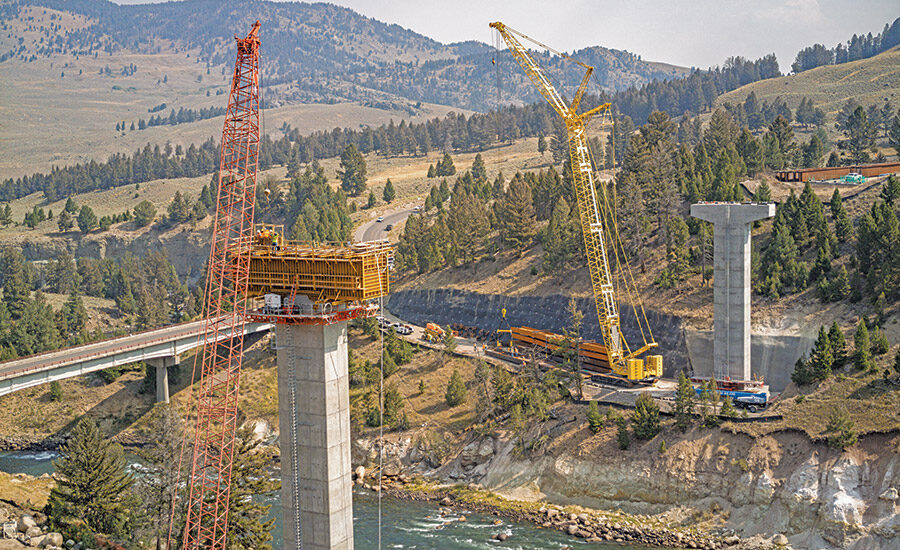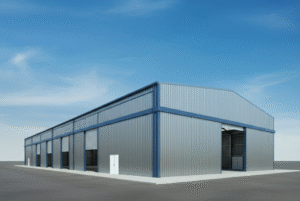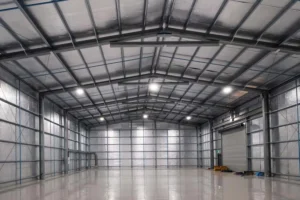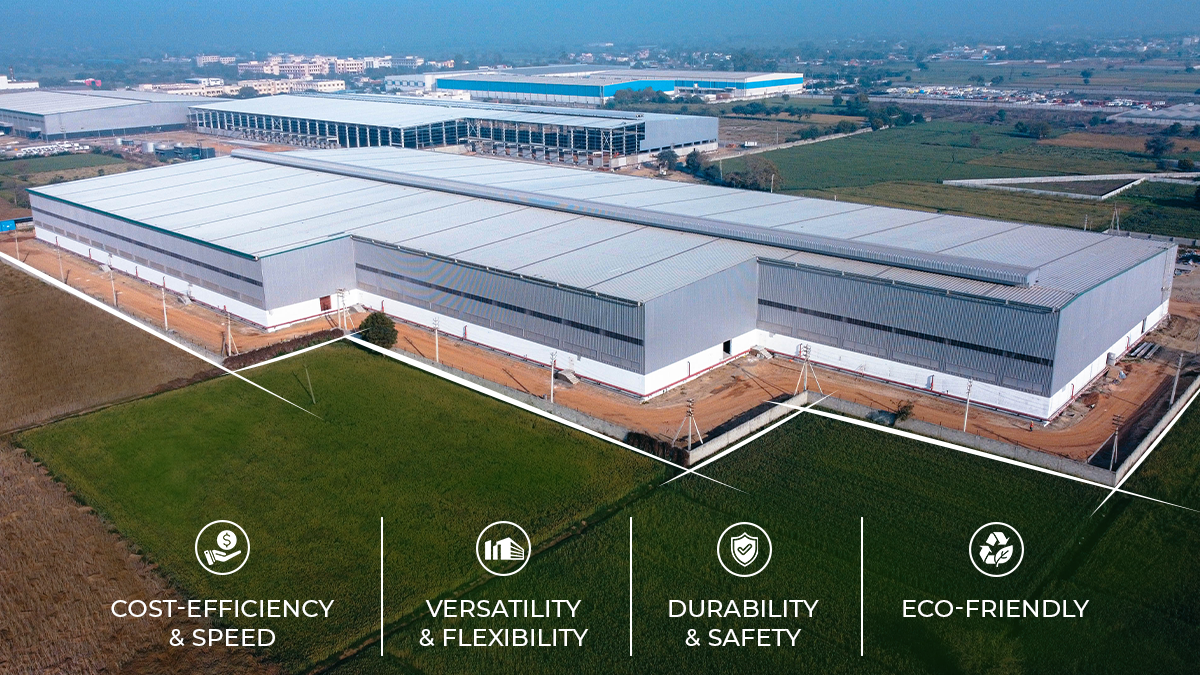
Yellowstone River Bridge Sits Tall at Top of Canyon to Improve Safety, Access and Views
[ad_1]
Yellowstone National Park with its thermal geysers, bubbling mud pots and abundant wildlife is unlike any other place on earth, so it makes sense that building in this gem of the U.S. National Park system would come with its own unique set of challenges.
Since the spring of 2023, work has been underway on the replacement of the Yellowstone River bridge near Tower Junction at the northeast corner of the park. Despite challenges ranging from bears, bison and steep topography to a building site with ground heated by geothermic activity along with hot springs and gas vents, construction of the $120-million bridge is entering its final phases this summer and is expected to open in the fall. Rising 180 ft above the river gorge, the four-span steel plate girder bridge will replace the existing structure, which was built in 1961 and is located just 700 ft to the southeast.

In addition to replacing an aging bridge, the new river crossing will provide visitors with stunning views of the river canyon and surrounding terrain.
Photo courtesy U.S. National Park Service
Work on the project has been carried out in phases due to the limited construction season in the park, generally lasting from April to October. According to the Western Federal Lands (WFL) division of the Federal Highway Administration, the project scope includes the construction of the new bridge, the demolition and removal of the old bridge, the realignment of approximately one mile of the Northeast Entrance Road, new pull-outs and trailhead parking lots, restoration of the riparian area with native plants and the installation of a new fish barrier. The realignment of the road will permit the restoration of the nearby Lost Creek to its original channel, and the surrounding area will be restored to “pre-1960 conditions,” according to the WFL.

Daniel Rhodes, landscape architect for the National Park Service (in yellow vest) and an unidentified worker stand below the deck of the current Yellowstone River bridge, built in 1961. It will be demolished once the new bridge is completed. Rhodes will oversee restoration of the area at the end of construction.
Photo courtesy U.S. National Park Service
Jacob Kihm, project manager for Idaho Falls-based HK Contractors, the prime contractor for the bridge replacement project, says completion is slated for 2026.

The current bridge has little room for pedestrians or cyclists and is showing signs of wear from decades of extreme weather and heavy use.
Photo courtesy U.S. National Park Service
New Bridge at New Heights
The bridge, designed by Dallas-based Jacobs Engineering Group, is markedly taller and longer than the one it is replacing. In addition to its 180 ft height, the new bridge spans 1,285 ft with girders resting on three concrete piers. The existing bridge spans just 604 ft and, situated lower in the canyon, tops out at about 70 ft above the river with steep approaches on either side.
According to information from Jacobs and HK Contractors, the new location and height allow for the bridge deck to be grade level with the top of the canyon, affording better views for visitors, less excavation and improved safety by eliminating the steep approaches to the old bridge that can become more hazardous in the winter. The bridge is one of the few in the park open to the public year-round and provides a link to the Lamar Valley and Cooke City in Montana.
“We had to have a liquid cooling system for the concrete and monitor the temperature to make sure it was curing properly.”
—Jon Lowe, Project Manager, Ralph L. Wadsworth
It will have two lanes, a pedestrian sidewalk and carry a fiber optic line.
The area’s geothermal and hydrothermal activity present another uncommon challenge, says Jon Lowe, project manager for Draper, Utah-based Ralph L. Wadsworth Construction, the subcontractor for bridge construction and concrete.
“For the footings, we had to have a liquid cooling system for the concrete and monitor the temperature to make sure it was curing properly,” he says. Construction of the footings required a unique sulfate-resistant concrete, and workers wear air monitoring devices to measure the levels of hydrogen sulfide gas in the area.
“You’ve got people working at serious heights. We want to make sure everyone is safe,” he adds.
Lowe says working in the remote location requires a concrete batch plant set up about 15 minutes away at a site where the team is also stockpiling excavated material for reuse.
While the batch plant will supply concrete to finish the bridge deck, other concrete elements of the bridge are precast and shipped to the site.
Those elements include the three piers, the highest reaching 160 ft, which are constructed of stacked precast sections that are post-tensioned and waterproofed. Lowe says the RLW team suggested the use of precast panels for the bridge deck.

With piers that reach up to 160 ft, the Yellowstone River bridge sits level with the top of the canyon, eliminating the steep approaches to the old bridge and offering scenic views of the area.
Photo courtesy Ralph L. Wadsworth
“We use them a lot in Utah and Colorado, but we had to get approval from the Federal Highway Administration to use them. Originally, they were designed for metal pans. It was about a three- or four-month review process, but it will save time and money in the end,” he says.
The 65 steel girders, some up to 15 ft tall and 100 ft long, were fabricated by Utah Pacific in Lindon, Utah. Transporting them required extra planning, says Lowe.
“We wanted to have all the girders delivered at once because we knew, logistically, it was going to be a pain,” Lowe says. The team had to deal with tourist traffic and the fact that the Madison River bridge—the main access point from West Yellowstone—was unusable because it had a damaged section.
The steel was delivered via a slightly longer route over Dunraven Pass, the highest mountain pass on the park’s Grand Loop Road at 8,878 ft.
Lowe says the team has found other ways to make up some time lost due to the project’s logistical challenges that, in addition to the random bear or bison, have included the complicated delivery and placement of an 825-ton crane.
The nearly 600 precast deck panels from Plumb Creek Structures in Littleton, Colo., had arrived at the site while steel erection was in progress, and the team investigated the possibility of placing them early.
“Usually, you don’t start placing the deck panels until all the girders are in place,” Lowe says. “Our in-house engineers analyzed the limits of deflection we could have at different spans and found where we could start installing the panels before all the girders were complete.”
The team completed the girder placement in early May and began placing the precast deck panels, with plans to begin pouring concrete in June. “We’re pushing hard to make that November opening date,” he says.

The construction team has saved time and money with the use of precast concrete panels for the bridge deck. The panels will eventually be topped with concrete for the finished road surface.
Photo courtesy U.S. National Park Service
In addition to air quality, the team must monitor water quality in the river and make reports to the Dept. of Environmental Quality and the Environmental Protection Agency.
“And we’re gearing up for tourist traffic,” Kihm says.
Yellowstone receives about 4.5 to 5 million visitors each year, with peak volume of around 30,000 a day during the summer months, according to National Park Service data. The return of tourists also means relocating construction workers who had been housed in nearby hotels. “The contracts we had with the hotels ended in May. Western Federal Lands has provided some campsites nearby. We’ve got 35 trailers we’ll move once the snow is cleared,” says Lowe. “We’ll probably have about 50 people once we are ramped up this summer—some at the camp and some at a hotel.”
The spring snowmelt means the bears are waking up, too, and they’ve been seen wandering around near the site. “Adding a can of bear spray to your tool belt isn’t usually something you have to think about, but it’s just another thing we have to do here,” Lowe adds.
“We’re also on a bison migration route,” notes Kihm. “Access to our site is off the old road and the existing bridge, so sometimes we have to stop our hauling and traffic because there is a herd of bison wanting to cross.”
[ad_2]
Source link
Post a Comment
You must be logged in to post a comment.






